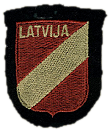18
The difference between the short-lived Self-Defense and its German sponsored successor, the Kartibas Dienests (headquartered at Annas Street), must be kept in mind while examining 1Hazners' alibi from July 10, 1941, when he joined the Self-Defense, until October of the following year, when he left Riga for Abrene. Seven witnesses say they saw him during this time, but not one of them places him at the Self-Defense Headquarters on Meierovics. 28/ In fact, the one witness who did work on Meierovics Street, Sirants, testified that he did not meet Captain Hazners until the move to Annas Street at the end of July or the beginning of August. (Sirants dep. 91)
Ludriksons and Meiers both saw Hazners at Merkela Street (where the Self-Government was located) during July, but only occassionally and for brief periods. Meiers said:
| A: | He had no job at Merkela Street; that was only come to see officers, get information, go away, come again next day. | |
| * * * | ||
| Q: | How long was he staying there when he came? | |
| A: | Couple of hours. |
(Meiers dep. 152)
In other words, a number of people saw Hazners between July, 1941 and October of the following year, but only two saw him between
| 28/ | The seven are Parups, Vuskalns, Ludriksons, Meiers, Sirants, Voitkus and Vilips. Vuskalns says Hazners started to work for the Self-Defense in July but indicates that the office was on Elizabeth Street, which is 4 or 5 blocks from Meierovics. (tr. 12183) Moreover, Vuskalns testified that his job was to supply the troops on the Russian front. The Kartibas Dienests are known to have fought on the front, 2but there is no evidence that the Self-Defense forces did. This, together with the fact that the witness could not remember the street where the Self-Defense was located, 3tends to show that he never worked on Meierovics. |
Examination
1“Hazners' alibi from July 10, 1941, when he joined the Self-Defense, until October of the following year, when he left Riga for Abrene. Seven witnesses say they saw him during this time, but not one of them places him at the Self-Defense Headquarters on Meierovics.” . . . [footnote] 3“tends to show that he never worked on Meierovics”
The INS goes through a torturous argument that Hāzners did not work at the Self-Defense headquarters on Meierovics street, then contends there was "no evidence" that Veiss' command—not specifically, but referring to the overall organization—provided men for the the front, as if this somehow countered Hāzners's alibi. Surely the INS was aware of the duplicity of their line of argumentation—that is, construct a picture based on generalities by purporting ignorance of Hāzners's files from German authorities. Either Veiss' or Hāzners's file would have indicated Veiss commanded the Rekrutierungsreserve, which while intended to provide domestic security duty, was, in fact, tasked with readying men for service along the Latvian frontier and in front-line combat.
Records would also have shown Veiss' actual call for self-protection volunteers issued July 8th requested men to report to No. 60, Miera street, not Meirovics street.
Central to the INS's case that it completely ignores Veiss' unit and bases its contentions purely on organizational culpabilities and which organizations were headquartered where and when.
Anyone familiar will logic will know that it is impossible to prove a negative, that "no" Self-Defense forces fought on the front. The INS ignores records related to Veiss' unit and Hāzners's duties as his adjutant in training and preparing combatants, leaving it free to speculate and engage in logical gymnastics as it pleases.
| 1 | Testimony of Valentins Sirants, 1-November-1978, deposition. |
| 2 | Testimony of Janis Meiers, 1-November-1978, deposition. |
| 3 | Testimony of Vilhelms Vuskalns, 10-April-1978, direct, transcript pp. 1212–1218. |
